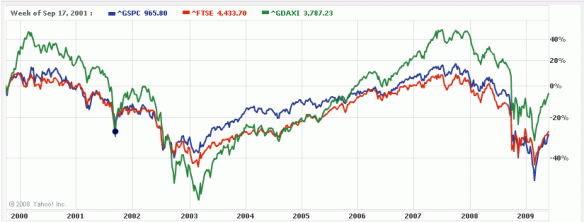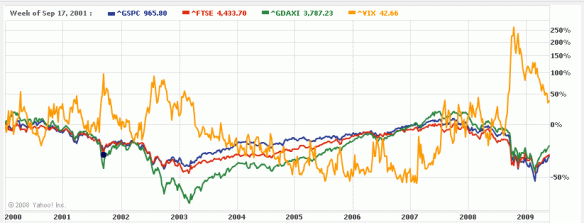I prefer to do the most basic charting imaginable. I just look at history and try to find times that resemble the present. In tonight’s browsing of the record of mankind’s opinion of its future, my eye zeroed in on September 2001 to March 2002. The dot marks the week of September 17, 2001:
This interim bear market bottom came 18 months after the all-time peak. Sound familiar? We had a dramatic sell-off into that bottom followed by a very sharp recovery, no doubt boosted by desperate short-covering. The bounce had covered most of its total ground within three months, but it was not until the VIX retreated to levels last seen at the top of the previous bounce that the indexes registered their final highs. This occurred after another three months of choppy trading, after which the VIX snapped right back to panic levels and stocks began to roll over into the final descent of the three-year bear market.
If this is our fate, perhaps the S&P chops its way to 1050 by September and the VIX touches 20. In that scenario, a lot of pain awaits holders of puts and inverse ETFs, and a lot of gain awaits patient buyers of the same.
I don’t feel like posting 10 charts here, but I couldn’t help but notice how many major market turns have come in September and March. These are the equinox months, and I believe we are primed to experience a collective shift at these times as a remnant of our past as farmers and hunter/gatherers whose livelihoods were very much tied to the seasons. If anyone has the time and know-how, it would be interesting to see if the numbers back up this hunch.



you mentioned at the end of the most recent blog the seasonal turning points…note that there are two penumbral lunar eclipses sandwiching a solar eclipse in July. These also are markers of periods of “instability”, shall we say.
I don’t buy the eclipse effect. We’ve evolved to respond to seasons for clear reasons (get out and plant in the spring / prepare for winter in the fall), but why should eclipses bring any change in behavior? They are just curiosities.
I think human evolution’s influence on behavior based on the seasons is based more on the migration of animals, than agriculture.
SovSpec-
You’re too bullish for me. I think yesterday was the top:
http://goldversuspaper.blogspot.com/2009/06/stock-market-top-is-in.html
Hey Adam.
It’s certainly possible. I just don’t think that markets often go straight up to their tops like this. You need some squiggles to work through the stages of emotion and mess with people’s heads. Basically 3 or more moves before a trend is exhausted.
I also respect the “one big correction” chart. I’ve long considered it myself. I just lean “bullish” since I think March was a substantial bottom, based on extremely low bullish sentiment readings – 2%. Out of such a bottom of a 17 month slide, I figure you need more than a 3 month bounce.
The amount of bullishness is a bit stunning, though, so I definitely can see a nice deep correction. If not, we’ll have to bounce around up here for several weeks to work it off.
All of that said, I’m already pretty darned short stocks, PM and non-dollar currencies. I’m long bonds.
BTW — You’re more bullish than me in a way: I think we’re going under 300 on the S&P — and that’s the polite version!
BTW, here’s a good paper on seasonality:
http://gbr.pepperdine.edu/064/stockmarket.html
Regarding herd-like behavior:
http://news.msu.edu/story/6401 (not about stocks, about gangs. Gang membership make people feel safe, even though they are more likely to die than non-gang members who live in the same region. )
I do not know how low stocks will go… 450-400 seems realistic from an ex ante perspective. Could get lower, but I think it would be best to close positions then before Bernanke launches the “Taxpayer Assurance Equities Facility.”
http://seekingalpha.com/article/140776-stocks-will-fall-37-or-gold-will-rally-60?source=article_sb_popular
Eventually, the entire equities bubble has to burst. I do not want to call a bottom in nominal terms, but instead in rhetorical terms. I will say that the bottom will happen when the Darwinian flush of the market participants is completed.
Nota bene: the wealthy still own a majority of the stocks (I think.) so retail investors do not hold a majority of the shares. I wonder how do we feed this dynamic in the proper game theory context. What are their motivations for owning stocks (asset price inflation or they actually did a Graham-Dodd like analysis and bought stocks because it had a nice discounted cash flow [I expect the discounting to be higher in this environment] or for cash flow)?
Maybe some black swans include increasing protectionism such as countries boldly breaking WTO agreements and (don’t laugh when I say this) a serious attempt by the US government to reduce its deficit (maybe a replay of 1937 in the US or 1997 in Japan?). I suppose those are more likely in the short-medium term than the hyperinflation black swan Taleb is betting on. It is not a black swan when everyone is anticipating it.
Still a deflationist:
http://the-american-catholic.com/2009/02/17/inequality-and-the-new-aristocracy/
(See the manufacturing graph…)
Class, Repeat after me:
Bear market rallies end on good news.
I wouldn’t be surprised if there would be a sell-off when a “good” jobs report shows up, and the headlines on MarketWatch say “Jobs Report: Not as Bad as Economists Predictions.”